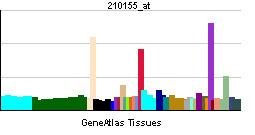Entrez 4653 | Ensembl ENSG00000034971 | |
 | ||
Aliases MYOC, GLC1A, GPOA, JOAG, JOAG1, TIGR, myocilin External IDs MGI: 1202864 HomoloGene: 220 GeneCards: MYOC | ||
Myocilin, trabecular meshwork inducible glucocorticoid response, also known as MYOC, is a protein which in humans is encoded by the MYOC gene. Mutations in MYOC are a major cause of glaucoma.
Contents
Function
MYOC encodes the protein myocilin. The precise function of myocilin is unknown, but it is normally secreted into the aqueous humor of the eye. MYOC mutations, which cause myocilin to accumulate in the cells of the trabecular meshwork are a common cause of glaucoma.
Myocilin is believed to have a role in cytoskeletal function. MYOC is expressed in many ocular tissues, including the trabecular meshwork, and was revealed to be the trabecular meshwork glucocorticoid-inducible response protein (TIGR). The trabecular meshwork is a specialized eye tissue essential in regulating intraocular pressure, and mutations in MYOC have been identified as the cause of hereditary juvenile-onset open-angle glaucoma.
Clinical significance
MYOC contains a signal sequence for secretion, and is secreted into the aqueous humor of the eye by the trabecular meshwork. Mutations in MYOC are found in 4% of adult-onset primary open-angle glaucoma and >10% of juvenile-onset primary open-angle glaucoma. Overexpression or underexpression of MYOC does not cause glaucoma. However, the MYOC gene also contains a signal sequence, which is normally not functional, that directs intracellular proteins to peroxisomes. Glaucoma-associated mutations activate that signal sequence and direct myocilin to peroxisomes, where they accumulate in the cell, instead of being secreted. Decreased secretion and increased accumulation appear to be the initial steps in myocilin-associated glaucoma.
Interactions
MYOC has been shown to interact with OLFM3.
